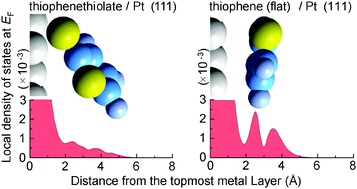Local electronic properties at organic–metal interfaces: thiophene derivatives on Pt(111)
Abstract
The valence electronic states of

* Corresponding authors
a Department of Basic Science, Graduate School of Arts and Sciences, The University of Tokyo, Komaba, Meguro, Tokyo 153-8902, Japan
b Faculty of Engineering, Yokohama National University, Tokiwadai 79-5, Hodogaya, Yokohama 240-8501, Japan
c Department of Physics and Earth Sciences, Faculty of Science, University of the Ryukyus, Okinawa 903-0213, Japan
d Division of Precision Science & Technology and Applied Physics, Graduate School of Engineering, Osaka University, 2-1 Yamada-oka, Suita, Osaka 565-0871, Japan
The valence electronic states of

 Please wait while we load your content...
Something went wrong. Try again?
Please wait while we load your content...
Something went wrong. Try again?
H. Sato, S. Ushiyama, M. Sogo, M. Aoki, K. Shudo, T. Sugawara, S. Yanagisawa, Y. Morikawa and S. Masuda, Phys. Chem. Chem. Phys., 2012, 14, 15412 DOI: 10.1039/C2CP42700A
To request permission to reproduce material from this article, please go to the Copyright Clearance Center request page.
If you are an author contributing to an RSC publication, you do not need to request permission provided correct acknowledgement is given.
If you are the author of this article, you do not need to request permission to reproduce figures and diagrams provided correct acknowledgement is given. If you want to reproduce the whole article in a third-party publication (excluding your thesis/dissertation for which permission is not required) please go to the Copyright Clearance Center request page.
Read more about how to correctly acknowledge RSC content.
 Fetching data from CrossRef.
Fetching data from CrossRef.
This may take some time to load.
Loading related content
